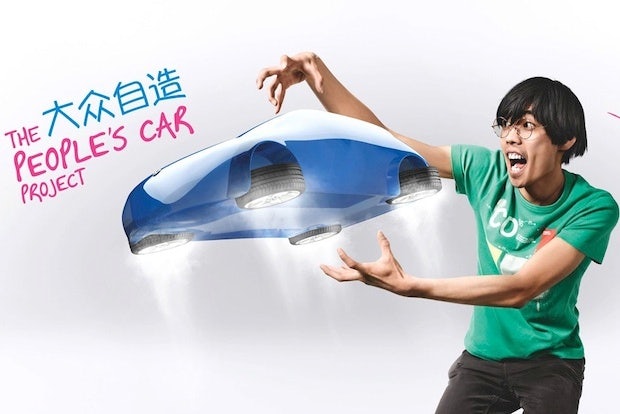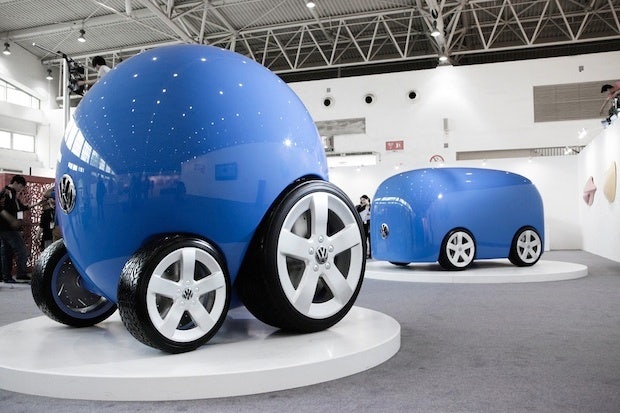
China’s car market competition may be heating up, but Goodstein Creative Director Georg Warga has certainly found one way to rise above the advertising clamor—release a viral video of Chengdu residents trying out a flying "hover car."
Speaking at the upcoming China Connect conference, which starts this Thursday in Paris, Beijing-based Warga has been working on the cutting edge of viral advertising in China through the creative agency he founded in 2010. The flying car that appeared in a simulated video in Chengdu was a part of Goodstein’s innovative and Cannes Lions-winning 2012 Volkswagen campaign, which called on Chinese fans to design the most imaginative cars they could dream of—and then developed three winning ideas into concept cars to be displayed at the Beijing Motor Show.
Recently, Jing Daily interviewed Warga about his experience working in the creative sphere of China’s rapidly evolving advertising world. Read on to see his thoughts on what works and what doesn’t with Chinese consumers, where marketing in China is headed in the coming years, and why he thought the Volkswagen campaign was so successful.
In the most general sense, how has the consumer landscape in China changed since eight years ago, when you first arrived?#
I started as Creative Director for Interone, a BBDO company, and my main client was BMW. We made BMW the most desired luxury car brand by the time I left the company in 2010. I often had the feeling then [that] what is expensive and new sells. Today, this has changed. The Chinese people desire bespoke content that creates context in their lives, not just bling.
Goodstein was the first China firm to win a Gold award at the Cannes International Advertising Festival in 2013 for the Peoples' Car Project, an interactive campaign for Volkswagen that solicited "dream car" designs from the public. Thirty million people submitted over 260,000 car ideas. How was the campaign promoted and at what point did it go viral?#
We told the people, "A car could be anything," and found hundreds of ways to express it to them, always fresh and always innovative. We built a universe of content, and at one point or another, consumers jumped on the wagon to give us their ideas. Once they realized that this was not a marketing stunt, they came back for more. After we displayed the first outcome of the project, an online video of a flying car that made its rounds in Chengdu, the project went viral—not only in China but everywhere else in the world. Jay Leno, the famous American talk-show host and car enthusiast called us to ask if he could buy that car. We knew then, we did the right thing.
We see a lot of social media campaigns that do free giveaways if the follower refers the post to friends. The Volkswagen campaign has a stronger call to action that requires creativity. What inspired the campaign and in turn, its participants?#
Give us an idea and win an iPad—I see this all the time. Doesn’t work for us. The payoff for consumers is vanity, not a cash prize. If their contribution shows to their friends how creative they are, that’s a win for them and for us.

Georg Warga.
In addition to the online call for design submissions, the campaign also incorporated a reality series featuring eight student teams and celebrity mentors. What was the rationale behind using this format as opposed to more traditional advertising or a short film commercial?#
We believe that content is the main driver for consumer engagement, not media buying. Sure, media amplifies, but if the content is not appealing or hits a certain nerve, it is all but wasted money. In the case of the series, we knew we had an interesting story to tell that resonates with "Originated in China," a story that was episodic in nature. The Chinese are proud of their achievement, and that drove the ratings of the series without huge media spending.
A lot of advertising campaigns only work because of the media spending—the creative is often irrelevant or just plain awful. At Goodstein we have developed a tool, a framework called "Plot." It helps advertisers to tell stories better, to sell better. It shows how and when to deploy content, [and] the roles of content types and distribution in social networks. Brands that follow these techniques can surpass traditional media buys and create "likes" as opposed to pay for them.
Director and competition mentor Jia Zhangke notes that to own a car is still considered a Chinese dream.#
For many Chinese, owning a car is still very aspirational. What are some key differences between marketing aspirational luxury items and mass consumer goods?#
Mass consumer goods are reliant on innovation, luxury products—not necessarily. My experience with BMW is that you have to guard brand values with a fortress and an arsenal of intelligent weapons. Good marketing for luxury is to stay firm to your values and not give in to competitors. The challenge is to say the same thing over and over again without being boring.
Once you have built that fortress, it takes a huge effort to move the needle in any other direction or create true innovation. An example: To make Mercedes a car for the driver, not for the driven, is almost impossible. Advertisers want "new" all the time, but [that may] often [not] be the better choice. Challenger brands struggle to create any ground because they jump too much. Say one thing, then say it again [to be] better and more refined.

The Peoples’ Car Project asks people to imagine their dream car, and I was reminded of Xi Jinping's declaration of the "Chinese Dream." Did your team glean any insights into what the “Chinese Dream” looks like based on the 260,000 ideas submitted? What were some major themes that surfaced during the vetting process?#
Absolutely, the whole point of the project was to find the insights to create a car that satisfies the Chinese consumer of tomorrow. One of the biggest challenges in China today—just look outside the window—is traffic and air pollution. In Beijing, we just had another day that was beyond the index of the PM 2.5 readings. People are aware of this, yet they depend on their cars or don’t want to give up the freedom that comes with it. As a result, cars will become more of a living room and you will spend much more time in it than today with your family, friends, and colleagues. It offers entertainment and communication—not as an iPad like screen on a backrest, but as a fully immersive experience. The windows will become screens in their own right, and while you watch the news, you drink tea that is stored and purified from rainwater. One of the people’s ideas was that the cars themselves work as air purifiers. They suck in pollution from the traffic and exhaust clean air. [I] can’t wait to see this car driving on the street.
One of the campaign slogans is "making of an original." Yet, the campaign also promotes the idea that car innovation is a marker of civilizational progress, linking the outcome of the design competition to a major moment in Chinese (auto) history. Therefore, the campaign is both forward-looking and rooted in tradition. What role does history play when it comes to innovation marketing in China?#
We have just finished an online short film for telecommunication giant Huawei. It is a tablet computer-meets-phone and it comes with functions that no competitor offers in the world right now. "Originated in China" will be the new "Made in China." Give it five more years and people everywhere will acknowledge Chinese creativity. Innovation marketing must acknowledge these movements and support creators and innovators to reach their goals faster. Brands that understand this have a huge advantage over the "me-too" mentality-driven advertisers that think innovation only comes from California.
According to a recent Business Insider article, the Chinese car market grew nearly 14 percent in 2013, extending its lead in the global market. As the market continues to grow and consumers become savvier, what are some trends you see in car marketing in 2014 and beyond?#
As all brands look for China into growth the truly clever ones are looking into loyalty. It is time to move from "new" to "proven."